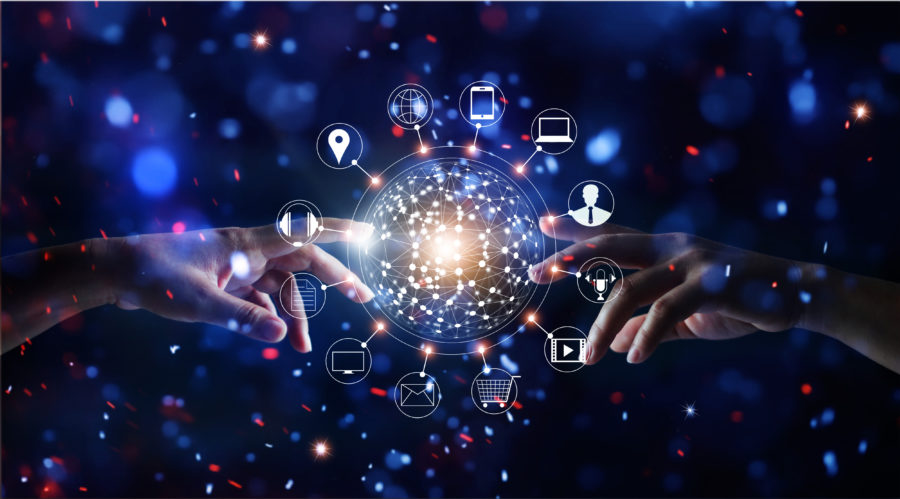Traditionally, organizations have adopted an Omnichannel approach to unifying the customer experience, but this is often not sufficient or successful in delivering ROI. Omnichannel only cares about and manages the customer-enterprise interaction. This is important of course, but going forward, and in order to better serve the customer, organizations need to further tap into their entire ecosystem of employees, suppliers, partners, external data sources and service—what Axway calls Customer Experience Networks—whether the customer is in a B2B or B2C industry.
Unlike Omnichannel, a CX network is focused outside-in, combining data from everywhere with contextual intelligence to create a unique ecosystem for each individual customer as they go about their daily lives.
Picture this with Omnichannel
- A shopper’s ecosystem that combines retailers, product manufacturers, banks, consumer rating providers, sales tax collectors and social media app developers.
- A patient’s ecosystem that touches hospitals, doctor’s offices, pharmacies, drug manufacturers, insurance payers, food diary developers and meal delivery providers.
- A driver’s ecosystem that spans auto dealers, repair shops, satellite radio providers, weather forecasters, traffic app developers, parking space providers and fueling stations.
The question is no longer
The question is no longer: “What is the profile of my customers and what product or service can I offer them to meet their expectations?” Rather: ”What will be the future behavior of my customers and how can my entire ecosystem help me in creating and supplying my customers with what they will need?”
It’s a fact, you cannot know your customers by yourself, only via the interactions you have with them. Past behavior and purchase history do not necessarily extrapolate into predictions and expectations. To anticipate your customers’ behavior, you will need to know much more about them, from external data sources that come from your partners’ network, government bodies, banks and other institutions. You will need to anticipate the customer’s life events, environmental changes, supply capabilities from tier N. This also includes potential supply disruptions due to social upheavals or weather catastrophes anywhere in the world.
The challenge is that the “external data sources” you would need are not always available in some form of external database to which you can subscribe. You will need to create the interaction network with your ecosystem that will help you derive the data and build the knowledge you need about your customers, to serve them better, and about your partners, to help them serve you better.
You will need to build an ecosystem network, where each member brings value by the very fact that they are part of it. In a similar manner to Facebook, LinkedIn, and many other platform models, the whole will be greater than the sum of the parts. Members (customers, partners, suppliers) will then contribute value, foster innovation and your enterprise will be at the heart of it to leverage benefits.
With customer experience networks, you will be able to
- Continuously anticipate and adapt to changing market conditions and customer expectations
- Quickly design and introduce new products and services to differentiate from competitors
- Easily collaborate with new stakeholders across value chains that were not accessible before
- Efficiently develop, launch, and industrialize new business models to capitalize on new revenue streams and grow your bottom line
CX networks will open endless possibilities
Imagine a manufacturer who successfully builds a platform that connects many organizations and data from across the manufacturing ecosystem—suppliers to the Nth level, customers and potential customers, logistics providers, weather forecasting data, government statistics, dealerships, distributors and so on. The immediate value to each one of these players would be access to an up-to-date directory, with business addresses as well as technical addresses for B2B connectivity via EDI or API. Add to this, access to supply chain events that enable end-to-end visibility and provide anticipated alerts. Historical data on maintenance, for example, could be combined with government sources on average wealth per region to anticipate future purchase behaviors.
You could also invite members to collaborate on the design and capabilities of your new products, as one luxury automotive manufacturer has done with a great degree of success, increasingly use social media to be seen as inclusive by audiences, and leverage mobile technology to provide customers with a seamless experience across all touchpoints, both online and offline.
Engagement is central to CX networks
Engagement, which allows for two-way flows of information and communication, is central to CX networks. This means that manufacturers, distributors, suppliers and partners will need to integrate their respective data sources to be able to understand and most efficiently serve the customer.
Implementing a CX network is largely about creating a community
Its success will reside in how fast you can achieve a critical mass of interactions with your ecosystem organizations. From a technical point of view, you will need an integration platform with at least the following capabilities:
- An API Management layer that allows you to publish your service interfaces and make them accessible to all CX network members while enforcing security, authentication and confidentiality of information.
- A mobile application development framework that accelerates time to market of mobile app development.
- Analytics technology that allows you to measure usage and performance, have visibility on supply chain processes and obtain predictions on future customer behavior and trends.
- Integration technology, including EDI, MFT and API that allows you to exchange business documents with partners and integrate network members’ data.
- A member directory tool that automates member onboarding and lifecycle, keeps member business details up-to-date and maintains technical details for automated business interactions.
Ready to jump to the next level?
Discover how to succeed in the experience economy “The Road to Digital eBook.” Read more about Omnichannel here.
Learn how to Become a Proactive Supply Chain with Command and Control.
